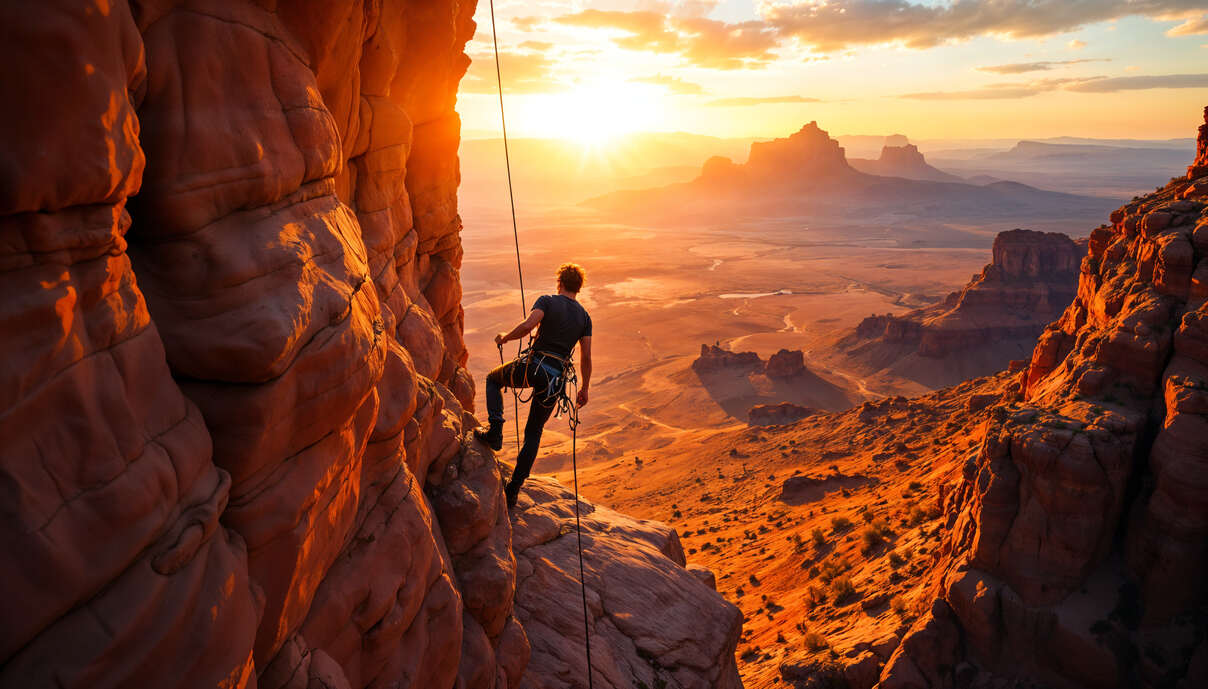Rock climbing combines adventure, strength, and strategy, drawing over 7.7 million participants in the U.S. alone as of 2019. Yet, this thrilling sport carries inherent risks, with 93% of climbing injuries linked to overuse or human error, according to the American Alpine Club’s Accidents in North American Climbing (ANAC).
From beginners scaling gym walls to seasoned alpinists tackling remote peaks, accidents can happen to anyone. The good news? Most are preventable with proper knowledge and preparation.
This article explores the top 10 rock climbing accidents, their causes, and practical safety tips to keep you secure on the rock. Drawing from real-life incidents, expert insights, and statistical data, we’ll equip you with the tools to climb confidently. Whether you’re a novice or a veteran, understanding these risks is the first step to staying safe.
Why Rock Climbing Accidents Happen
Before diving into specific accidents, it’s critical to understand why they occur. Climbing accidents stem from two main sources: objective hazards, like rockfall or sudden weather changes, and subjective hazards, such as inexperience or complacency. ANAC reports that human error accounts for 80% of climbing mishaps, a sobering reminder that preparation and vigilance are non-negotiable.
A unique factor often overlooked is the psychological trap of complacency. Experienced climbers, confident in their skills, may skip safety checks or underestimate routes, leading to preventable errors. For instance, a 2023 gym incident saw a seasoned climber fall 20 feet due to a rushed knot check. Recognizing these risks—environmental, technical, and mental—sets the stage for safer climbing.
The Top 10 Dangerous Rock Climbing Accidents (And How to Avoid Them)
Below, we detail the 10 most common rock climbing accidents, each with real-life examples, statistical insights, and expert-backed prevention strategies. By learning from these incidents, you can climb with greater confidence and safety.
1. Improper Belaying
Belaying errors occur when a belayer is distracted or uses incorrect techniques, leading to falls. In 2023, a Colorado gym climber suffered a fractured pelvis after a 20-foot fall when their belayer forgot to adjust gear. ANAC notes that belaying mishaps contribute to 10–15% of climbing accidents.
How to Stay Safe:
- Perform Partner Checks: Before climbing, verify harness buckles, rope setup, and belay device functionality with your partner.
- Stay Focused: Maintain eye contact with the climber and avoid distractions like phones.
- Use Assisted-Braking Devices: Devices like the Petzl Grigri reduce the risk of human error.
2. Rope Failure or Mismanagement
Worn-out ropes or improperly tied knots can lead to catastrophic falls. Legendary climber Lynn Hill’s 1989 75-foot fall in France, caused by an unfinished knot, is a stark example. Rope-related issues account for 10% of climbing injuries, per ANAC.
How to Stay Safe:
- Inspect Ropes Regularly: Check for fraying, cuts, or core damage, and retire ropes after heavy use (typically 1–2 years for frequent climbers).
- Tie Stopper Knots: Add a backup knot at the rope’s end to prevent lowering accidents.
- Double-Check Knots: Ensure figure-eight or bowline knots are secure before climbing.
3. Anchor Failure
Weak or poorly placed anchors can fail under load, causing climbers to plummet. In 2009, a Red River Gorge accident saw two climbers die when a webbing rappel anchor failed. Anchor failures rank among the top causes of fatal climbing accidents, according to ANAC.
How to Stay Safe:
- Use Redundant Anchors: Build anchors with at least two (preferably three) secure points.
- Check Fixed Gear: Inspect slings and bolts for wear, especially UV damage on webbing.
- Learn Anchor Building: Practice equalizing anchors to distribute weight evenly.
4. Rockfall Injuries
Loose rocks dislodged by climbers or natural causes can strike climbers or belayers, often with severe consequences. A 2023 incident at Wizard’s Gate injured a belayer when a rock fell from above. Rockfall accounts for 15% of climbing injuries, frequently causing head trauma, as per PMC studies.
How to Stay Safe:
- Wear a Helmet: Use a UIAA-certified helmet for all types of climbing, including sport routes.
- Avoid Crowded Routes: Stay clear of areas below other climbers to minimize rockfall risk.
- Position Belays Strategically: Set up belays away from potential fall zones.
5. Weather-Related Accidents
Sudden storms, lightning, or hypothermia can turn a climb into a survival scenario. In 2019, Yosemite climbers were stranded when a storm rolled in unexpectedly, highlighting weather’s unpredictability. Weather-related incidents contribute to 5–10% of climbing accidents, per ANAC.
How to Stay Safe:
- Check Forecasts: Use apps like Windy to monitor weather before and during climbs.
- Pack Proper Clothing: Carry layers to protect against cold, rain, or heat.
- Recognize Weather Signs: Learn to spot cloud formations or wind shifts indicating storms.
6. Overuse Injuries
Repetitive strain leads to chronic injuries like tendonitis, particularly in gym climbers. A 2022 study found that 93% of climbing injuries are overuse-related, with elbows and shoulders most affected. Overtraining on hangboards is a common culprit.
How to Stay Safe:
- Incorporate Rest Days: Allow 48 hours between intense sessions to prevent strain.
- Warm Up and Stretch: Spend 10–15 minutes on dynamic stretches before climbing.
- Avoid Overtraining: Beginners should limit hangboard use until they build strength.
7. Bouldering Falls
Bouldering’s low-height falls can still cause significant injuries, especially to ankles or heels. A climber at Stanage broke their heel on a highball boulder despite crash pads. Bouldering injuries are frequent but often minor, per PMC data.
How to Stay Safe:
- Use Multiple Crash Pads: Ensure adequate padding and overlap for large landing zones.
- Practice Spotting: Spotters should guide falling climbers to land safely on pads.
- Know Your Limits: Avoid highball problems without ropes if you’re inexperienced.
8. Rappelling Errors
Rappelling mistakes, like descending off the rope’s end or using weak anchors, are deadly. A 2023 Squamish accident saw a climber fall 200 feet during a counterweight rappel. Rappel errors cause 30% of fatal climbing accidents, per ANAC.
How to Stay Safe:
- Use Backup Knots: Tie an autoblock or Prusik below the rappel device.
- Verify Rope Length: Ensure the rope reaches the ground or next anchor.
- Communicate Clearly: Confirm plans with partners before descending.
9. Exceeding Skill Level
Attempting routes beyond one’s ability leads to falls or strandings. In 2022, an unroped climber fell on Teewinot due to inadequate skills, highlighting the risks. Exceeding skill level is a leading accident cause, per ANAC.
How to Stay Safe:
- Match Routes to Skills: Choose climbs within your grade and experience level.
- Train with Mentors: Work with experienced climbers or guides to build skills.
- Practice Downclimbing: Develop techniques for safe descents in emergencies.
10. Inadequate Route Planning
Poor planning can leave climbers lost or stranded. In 2019, climbers in Mexico were stranded due to unfamiliar routes, requiring rescue. Descent issues, often tied to planning, account for 33% of accidents, per ANAC.
How to Stay Safe:
- Research Routes: Use guidebooks or platforms like MountainProject for beta.
- Carry Navigation Tools: Bring a map, GPS, or downloaded route details.
- Plan for Emergencies: Pack extra food, water, and gear for unexpected delays.
You might also interested in rock climbing gears.
Expert Advice to Prevent Climbing Injuries
Experts emphasize preparation and mindfulness as key to safe climbing. Ron Funderburke, Education Director at the American Alpine Club, advises, “Self-assessment and redundancy are critical to avoiding accidents.” Climbing author Stewart M. Green adds, “Never skip gear checks, no matter how routine the climb feels.” A unique perspective comes from Alex Honnold’s approach in Free Solo, where mental preparation—visualizing risks and solutions—helped him manage fear and uncertainty. Enrolling in climbing courses, like those offered by the American Mountain Guides Association, can also build critical skills.
Your Climbing Safety Toolkit
To climb safely, equip yourself with the right tools and knowledge:
- Downloadable Checklist: Use our pre-climb safety checklist to verify gear, knots, and weather conditions.
- Recommended Gear: Choose UIAA-certified helmets (e.g., Petzl Meteor), harnesses (e.g., Black Diamond Momentum), and ropes.
- Resources: Read Accidents in North American Climbing or explore MountainProject for route beta.
- Apps: Use Windy for weather updates and AllTrails for navigation.
Climb Smart, Stay Safe
The top 10 rock climbing accidents—from belaying errors to poor planning—share a common thread: they’re largely preventable. By prioritizing preparation, vigilance, and education, you can minimize risks and enjoy the sport’s rewards. As Alex Honnold says, “The only way to stay safe is to stay sharp.” Download our safety checklist, share your tips in the comments, or join a climbing community to stay informed. Climb smart, stay safe, and keep exploring the vertical world!

